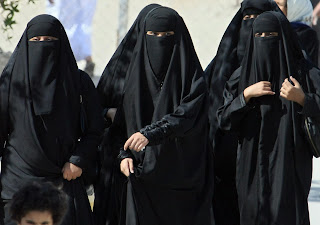Traditional Dress of Saudi Arabia
Dress for Women:
Abaya: The abaya is the traditional outer cloak of a woman's clothing. It consists of a long black dress that leaves only the wrists exposed, as well as a head piece which often covers everything but the eyes. The abaya is always black, and is either silk or synthetic material. Under the abaya, women will wear either a traditional bright colored dress embellished with coins or other designs, or western dress. Modern, western style dress has become increasingly popular, however an abaya is always worn on top.
Dress for Men:
Thawb/Thobe: This refers to the typical long sleeved dress. As the centerpiece of all traditional dress, it is worn by all locals, and is usually made of cotton or synthetic fabric. They are worn in white during spring and summer, and are black or blue in winter. The thawb in Saudi Arabia differs from neighboring countries in that it will typically have buttons on the collar and sleeves that are as tight as a regular shirt, with holes for cufflinks.

 Ghutra and Igal: The ghutra is the main portion of a Saudi man's headdress. It is the red and white keffiyeh square of fine cotton cloth that is folded and wrapped around the head, traditionally to protect one's head from sun exposure and sand during dust storms. The ghutra is held in place by the igal, which is an accessory of double black hoops. Its yarns are typically synthetic or goat wool.
Ghutra and Igal: The ghutra is the main portion of a Saudi man's headdress. It is the red and white keffiyeh square of fine cotton cloth that is folded and wrapped around the head, traditionally to protect one's head from sun exposure and sand during dust storms. The ghutra is held in place by the igal, which is an accessory of double black hoops. Its yarns are typically synthetic or goat wool.





Often times, both traditional and modern clothing are interchangable in society. People will wear what they decide is their way of expressing themselves. However, Saudi Arabia is not necessarily the most liberal area in the world. As we saw in the documentary we watched in class, the government rules the country very strict, and there is usually very little wiggle-room for personal interpretation or expression of one's identity. Is it the case that traditional dress in Saudi Arabia is more of a demand than an individual's choice? With the Abaya specifically, women will wear modern, western clothing underneath it. If anyone, men or women, were to wear just modern clothing in lieu of the traditional dress, what would the communal reaction be? I am curious as to how much of people's clothing choices is a "conservative/traditionalistic" society and how much is pressure from society, the community, and the government.
ReplyDeleteI loved how you analyzed the different types of dress its really interesting how little variation there is in the women's dress on top despite expressive and/or Western clothes being worn underneath. The fact that Middle Eastern women are using jewelry and bright colors underneath their Abaya actually makes me a little bit sad because nobody can see their self expression except those directly in the household or related (and the jewelry is gorgeous). It seems that the outer clothing for both men and women are always rather plain as you described, they are only black, grey, beige, brown, etc. The pictures you included were super helpful in better understanding dress in Saudi Arabia, yay good job!
ReplyDelete